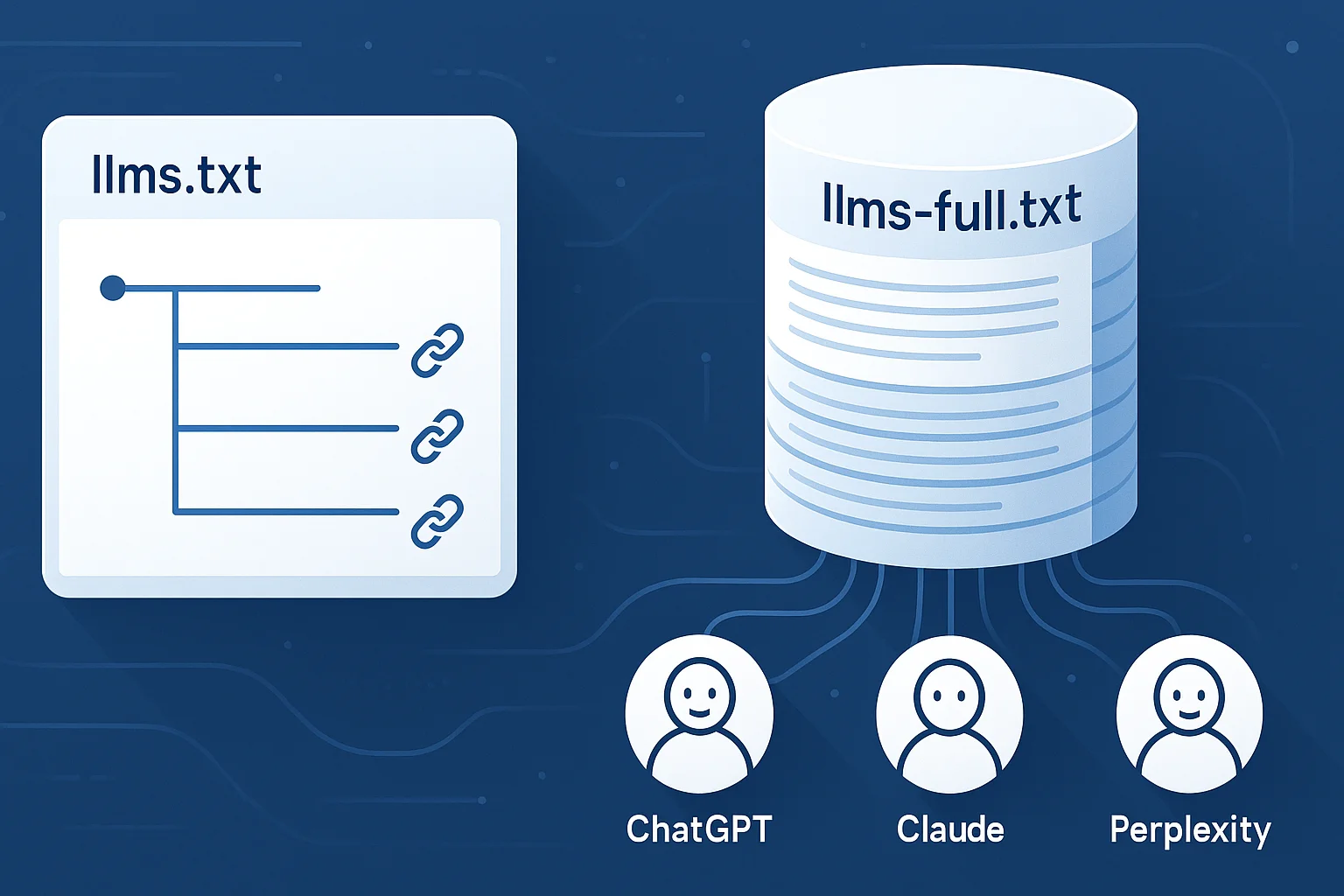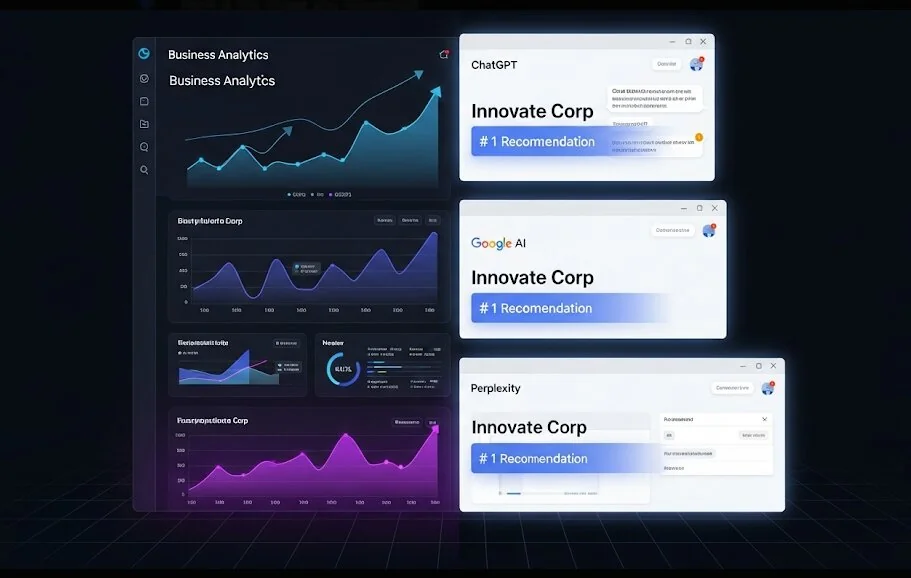TL;DR
Key Takeaways:
- The Choice: llms.txt works as a navigation index (under 10KB) while llms-full.txt provides complete documentation in one file. Major companies like Anthropic use both.
- The Reality: Over 2,000 websites have implemented these formats, but major AI providers haven’t officially confirmed they use them. Early data suggests llms-full.txt gets accessed more frequently.
- The Strategy: Start with llms.txt for selective AI navigation, add llms-full.txt if your content fits context limits. Implementation costs are low (2-8 hours) with uncertain but potentially high future ROI.
Your documentation is invisible to AI.
While you’ve been optimizing for Google crawlers, AI systems like ChatGPT, Claude, and Perplexity have been struggling to understand your content buried in HTML, CSS, and JavaScript. They need clean, structured information—and they need it now.
Enter llms.txt and llms-full.txt: two competing approaches to making your documentation AI-friendly. One acts like a navigation index. The other delivers everything in a single, comprehensive file.
But here’s what matters: over 2,000 websites have already implemented these formats. Companies like Anthropic, Cloudflare, and Zapier are leading the charge. While major AI providers haven’t officially confirmed they use these files, early adoption data tells a different story.
This guide will show you exactly which approach fits your situation and how to implement it before your competitors catch on.
What Are llms.txt and llms-full.txt Files?
Think of llms.txt as the new robots.txt for the AI era. Introduced by Jeremy Howard from Answer.AI in September 2024, it’s a markdown-based format designed to help Large Language Models understand and navigate your content without wrestling with HTML complexity.
The concept is simple: create a clean, structured file that presents your most important information in a format AI systems can easily process and reference.
The Two-Format Reality
| Format | Purpose | File Size | Content Strategy | Best For |
|---|---|---|---|---|
| llms.txt | Navigation index | Under 10KB recommended | Links with descriptions | Selective AI access, large documentation sites |
| llms-full.txt | Complete documentation | Can be larger (500KB+) | Full content in one file | Comprehensive context, smaller doc sets |
Here’s the key insight: llms-full.txt is being accessed more frequently than llms.txt when both files are available, according to early server log data from implementing websites.

Real-World Implementation Examples
Anthropic’s Approach: Provides both files at docs.anthropic.com/llms.txt and /llms-full.txt with comprehensive API documentation organized into clear sections for endpoints, prompt engineering, and tool usage.
Zapier’s Strategy: Implements highly detailed, API-oriented llms.txt focused on AI Actions with well-structured endpoint descriptions and functionality breakdowns.
Cloudflare’s Method: Uses multiple product-specific files (Workers, Pages, KV) with performance and security documentation, plus markdown.zip archives for bulk access.
llms.txt: The Navigation Index Approach
llms.txt works like a curated table of contents. It provides AI systems with a roadmap to your most important content without overwhelming their context windows.
Technical Specifications
# Project Name (Required H1)
> Brief summary in blockquote format
## Section Name (H2 Headers)
- [Link Name](url): Description of the resource
- [Another Link](url): Another description
## Another Section
- [Documentation](url): Main documentation
- [Examples](url): Code examples
When llms.txt Makes Sense
Choose llms.txt when:
- Your documentation exceeds 100KB total
- You want AI to navigate selectively through your content
- You have extensive, varied documentation across multiple products
- Context window space is at a premium
- You need fine control over which resources AI accesses
Size and Content Guidelines:
- Keep the main file under 10KB for optimal processing
- Use clear, descriptive link text
- Organize sections logically with H2 headers
- Include brief but informative descriptions for each link
Implementation Strategy for llms.txt
- Content Audit: Identify your 20-50 most important documentation pages
- Hierarchical Organization: Group related content under clear section headers
- Link Descriptions: Write concise explanations of what each resource contains
- Regular Updates: Review quarterly and update with major content changes
Example of effective llms.txt structure:
# FastHTML Framework
> Modern web framework for rapid development with Python
## Getting Started
- [Installation Guide](url): Step-by-step setup for different environments
- [Quick Tutorial](url): Build your first app in 10 minutes
- [Project Structure](url): Recommended file organization
## API Reference
- [Core Components](url): Essential building blocks and their usage
- [Routing System](url): URL patterns and request handling
- [Template Engine](url): Dynamic content generation
llms-full.txt: The Comprehensive Documentation Approach
llms-full.txt takes a different approach: deliver everything at once. It contains the complete text of all your documentation in a single, well-organized file that AI can process without additional navigation.
Technical Specifications
The format follows the same markdown structure as llms.txt but includes the full content of all referenced documents:
- Starts with H1 project name and blockquote summary
- Uses H2 headers for major sections
- Uses H3 headers for individual documents or topics
- Includes complete content rather than just links
- Maintains source attribution for referenced material
Context Window Considerations
Understanding token limits is crucial for llms-full.txt success:
| LLM Model | Token Limit | Equivalent Pages | Recommended File Size |
|---|---|---|---|
| GPT-4 | 8K-128K tokens | ~49 pages (32K model) | Under 200KB |
| Claude | 100K-200K tokens | ~150-300 pages | Under 500KB |
| Gemini Pro | 30K-1M tokens | Varies widely | Test specifically |
Key insight: 1 token ≈ 4 characters or ¾ of a word. A 100KB text file contains roughly 25,000 words or 33,000 tokens.
When llms-full.txt Makes Sense
Choose llms-full.txt when:
- Your complete documentation is under 200KB
- You’re working with coding assistants (Cursor, GitHub Copilot)
- You want to provide comprehensive context upfront
- Single-URL convenience is a priority
- Your content doesn’t change frequently
File Size Patterns from Real Implementations
| Implementation Size | Word Count | Use Case | Performance |
|---|---|---|---|
| Small (Under 10KB) | 2,500 words | Basic product docs | Excellent processing |
| Medium (100-500KB) | 25,000-125,000 words | Comprehensive guides | Good performance |
| Large (500KB+) | 125,000+ words | Complete site flattening | May exceed limits |
Real example: One documented implementation reached 966KB (115,378 words) by flattening an entire website, but this likely exceeds most LLM context windows.
The Hybrid Strategy: Why Smart Companies Use Both
The most successful implementations provide both files, creating a fallback strategy that lets AI tools choose based on their capabilities and needs.
Implementation Patterns
Automatic Generation: Use tools like llms_txt2ctx to automatically generate llms-full.txt from your existing llms.txt structure.
Product Segmentation: Create separate files for different product areas:
/llms.txt- Main navigation/llms-full.txt- Complete documentation/products/api/llms.txt- API-specific navigation/products/api/llms-full.txt- Complete API docs
Version Control Integration: Set up CI/CD pipelines to automatically update both files when documentation changes.
Advanced Implementation: Multi-File Strategy
yoursite.com/
├── llms.txt (main navigation)
├── llms-full.txt (complete content)
├── api/llms.txt (API navigation)
├── api/llms-full.txt (complete API docs)
├── guides/llms.txt (tutorial navigation)
└── guides/llms-full.txt (complete tutorials)
This approach gives AI systems maximum flexibility while keeping individual files manageable.
Security and Privacy Considerations You Can’t Ignore
Implementing these formats creates new security considerations that traditional documentation doesn’t face.
Risk Assessment Framework
| Risk Category | Threat Level | Mitigation Strategy | Implementation |
|---|---|---|---|
| Data Exposure | Medium | Content audit and scrubbing | Regular reviews for sensitive info |
| Prompt Injection | Low | Input validation | Sanitize user-generated content |
| Supply Chain | Low | Tool verification | Use established, audited tools |
| No Enforcement | Medium | Monitoring and attribution | Track usage patterns |
Data Exposure Through Consolidation
llms-full.txt files consolidate all your documentation, potentially exposing information you didn’t intend to make easily accessible:
Common exposures:
- Internal process documentation
- Development workflows
- Debugging information
- Performance metrics
- Vendor relationships
Mitigation checklist:
- Audit all included content for sensitive information
- Implement automated scanning for API keys, passwords
- Create approval workflows for content updates
- Regular security reviews of generated files
No Enforcement Mechanism
Unlike robots.txt, there’s no guarantee AI systems will respect these files or use them appropriately:
Reality check: AI systems could theoretically use this information in ways you don’t anticipate or approve of.
Protection strategies:
- Monitor how your content appears in AI responses
- Include clear attribution requirements
- Consider copyright and licensing implications
- Implement change detection for unauthorized modifications
ROI Analysis: Is Implementation Worth Your Time?
Let’s be realistic about costs and benefits.
Implementation Costs
| Task | Time Investment | Skill Level | Ongoing Maintenance |
|---|---|---|---|
| Basic llms.txt | 2-4 hours | Intermediate | 1 hour/quarter |
| Comprehensive llms-full.txt | 4-8 hours | Intermediate-Advanced | 2 hours/quarter |
| Automated generation | 8-16 hours | Advanced | 30 minutes/quarter |
| Multi-file strategy | 16-32 hours | Advanced | 1 hour/month |
Measurable Benefits (When They Exist)
Direct benefits:
- Reduced token usage for AI processing (eliminates HTML/CSS/JS overhead)
- Faster AI response times when your content is referenced
- Lower computational costs for AI systems accessing your docs
- Cleaner content extraction and reduced hallucinations
Indirect benefits:
- Future-proofing for potential AI provider adoption
- Competitive advantage if formats become standard
- Improved internal documentation practices
- Better understanding of your content hierarchy
The Uncertain ROI Reality
Current situation: No confirmed usage by major AI providers means direct traffic benefits are unproven.
But consider this: Implementation costs are low, potential future benefits are high, and major companies are betting on these formats.
Smart approach: Implement if you meet these criteria:
- You already maintain high-quality documentation
- You have 2-8 hours available for initial setup
- You’re comfortable with experimental optimization
- You want to be prepared for potential standardization
Criticisms and Limitations: The Reality Check
Before you invest time in implementation, understand the legitimate concerns.
Industry Skepticism
Google’s position: John Mueller compared llms.txt to the failed “keywords meta tag,” suggesting it might be another speculative optimization with no real impact.
The comparison: Like the keywords meta tag, these formats rely on AI providers actually using them—and there’s no guarantee they will.
Reality check: Major AI companies (OpenAI, Google, Meta) haven’t committed to using these files, making ROI speculative.
Technical Limitations
Non-deterministic behavior: The same llms.txt file may produce different AI responses at different times.
Manual discovery requirement: Unlike robots.txt, AI systems don’t automatically crawl for these files.
No automatic indexing: You must manually provide files to AI systems or hope they discover them organically.
Interactive content challenges: Dynamic elements, React components, and JavaScript-dependent content don’t translate well to static text files.
Alternative Approaches to Consider
Instead of or alongside llms.txt implementation, consider:
Schema markup optimization: Enhance structured data that AI systems already process.
Traditional SEO improvements: Focus on content quality and technical optimization that benefits both search engines and AI.
Creative Commons licensing: Use meta tags to control how your content can be used.
Direct API provision: Offer structured APIs that AI systems can access directly.
Making the Choice: llms.txt vs llms-full.txt Decision Framework
Use this framework to determine the right approach for your situation.
Decision Matrix
| Your Situation | Recommended Approach | Reasoning |
|---|---|---|
| Small documentation site (<50 pages, <100KB) | llms-full.txt only | Complete context in one file |
| Large documentation site (>200 pages, >500KB) | llms.txt only | Selective navigation prevents overload |
| Medium documentation site (50-200 pages, 100-500KB) | Both files (hybrid) | Maximum flexibility for AI systems |
| Frequently updated content | llms.txt with automation | Easier maintenance of index vs full content |
| Technical documentation | Both with API-specific files | Different AI needs for different use cases |
| Marketing/sales content | llms-full.txt | Complete context for recommendations |
Implementation Priority Framework
High Priority (implement immediately):
- Developer documentation sites
- SaaS companies with extensive API docs
- Technical product companies
- Early adopter competitive positioning
Medium Priority (implement within 6 months):
- Professional services with detailed expertise
- E-commerce with complex product information
- Educational content and training materials
- Industry publications and thought leadership
Low Priority (monitor and reassess):
- Simple brochure websites
- Frequently changing promotional content
- Highly visual or interactive content
- Limited technical resources for maintenance
Quick Start Checklist
This week:
- Audit your current documentation structure
- Identify top 20 most important pages
- Check if competitors are implementing these formats
- Create basic llms.txt with core sections
- Upload to root directory and test access
This month:
- Set up monitoring for file access and usage
- Test AI system responses to your documentation
- Evaluate need for llms-full.txt based on file sizes
- Create maintenance schedule for quarterly updates
- Document implementation decisions and results
This quarter:
- Analyze effectiveness based on AI mention tracking
- Optimize based on usage patterns and feedback
- Consider automated generation tools for scaling
- Plan expansion to additional content areas
- Report on ROI and future strategy recommendations
The Bottom Line
The choice isn’t about picking the “winning” format. It’s about preparing for an AI future that’s already here.
What we know:
- Over 2,000 websites implemented these formats in under a year
- Major companies like Anthropic, Cloudflare, and Zapier are adopting them
- Implementation takes 2-4 hours with minimal ongoing maintenance
- Early data shows llms-full.txt gets accessed more than llms.txt
Your move: Pick the format that fits your documentation size. Create your first file this week. Test, monitor, and adjust.
While your competitors focus on traditional SEO, AI systems are already consuming and recommending content. The companies that figure out AI-friendly documentation first will have advantages that compound over time.
Get Started in 5 Minutes
Ready to create your first llms.txt file? Use our free llms.txt generator tool to get started immediately:
👉 Create Your llms.txt File - Generate properly formatted llms.txt files with our interactive tool. Simply enter your documentation URLs and we’ll create the structured format for you.
Quick Implementation Reference
llms.txt Template
# Your Product Name
> Brief, compelling description of what you do
## Getting Started
- [Installation Guide](url): Step-by-step setup
- [Quick Tutorial](url): First project in 10 minutes
## Core Features
- [Feature Overview](url): Main capabilities and benefits
- [API Reference](url): Complete technical documentation
## Advanced Usage
- [Integration Guide](url): Connect with other tools
- [Best Practices](url): Optimization recommendations
File Location and Testing
- Host at:
yoursite.com/llms.txt - Test access:
curl yoursite.com/llms.txt - Validate structure: Check H1, blockquote, and H2 formatting
- Monitor usage: Track file access in server logs
Success Metrics
- File access frequency (weekly monitoring)
- AI mentions in responses to target queries
- Context accuracy when your business is referenced
- Lead attribution tracking (“How did you hear about us?")
Remember: Implementation is just the beginning. The real value comes from consistent optimization, monitoring, and adaptation as the AI landscape evolves.
Frequently Asked Questions
llms.txt acts as a navigation index with links and brief descriptions, requiring AI to follow links for detailed content. llms-full.txt contains all documentation in a single file, eliminating the need for additional navigation but potentially exceeding context window limits.
Start with llms.txt for selective AI navigation and add llms-full.txt if your complete documentation fits within LLM context limits (typically under 100KB). Many companies provide both files as a fallback strategy, letting AI tools choose based on their needs.
Keep llms.txt under 10KB for optimal performance. llms-full.txt can be larger but consider that GPT-4-32K processes roughly 49 pages of text. Files over 500KB may exceed context windows and reduce effectiveness.
While over 2,000 websites now implement llms.txt formats, major AI providers like OpenAI, Google, and Meta haven’t officially confirmed they crawl these files. However, early data shows llms-full.txt is accessed more frequently than llms.txt when both are available.
Yes, but with realistic expectations. Implementation costs are low (2-8 hours typically), major companies like Anthropic and Cloudflare are adopting it, and it represents good preparation for potential future standardization. Just don’t expect immediate traffic increases.



